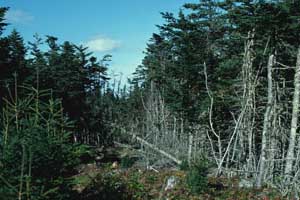|
|
 61 Seal Island succession DHJanzen101268.jpg high resolution
|
|
| A man-made clearing in the Seal Island white spruce forest is most revealing. This clearing was cut out of the forest about six years before this photograph. Were this to be done on the mainland, by now the clearing would be filled with a mix of at least 5 species of conifer and broadleaf fast-growing tree saplings, some dispersed by birds, some by mammals and some by wind. Here, there are no secondary successional species at all - just a few white spruce seedlings and saplings. For this clearing to be filled with secondary successional species of trees, there would have to be both parent trees in the vicinity and animals to move their seeds - there are neither on Seal Island. And were a robin to fly from the mainland with a belly full of mountain ash seeds (Sorbus americana, Rosaceae), what is the chance that there would be a clearing such as this one at just the point where it defecated in its first few days after arrival? A mountain ash seedling in the deep shade of image DHJanzen101267.jpg above is as dead as if its seed had fallen in the sea. How could the species richness be increased on an island of this size? Were it to have a small mountain on it, with its crumbling rocky slopes creating open places would increase the number of habitats. Were it to be downwind of the mainland instead of upwind, the seed rain would increase. Were it to be sufficiently close to the mainland that birds could readily see it and fly to it, the seed rain would increase. Were the winters to become cold enough that mammals would cross the ice to the island........ In short, many factors determine the details of how species-poor is an island compared to the mainland, but in general terms, the smaller the island and the further from the mainland, the fewer species it will have (and generally, the more abundant will be those species that are there). | ||
back to lecture slides
or skip to: